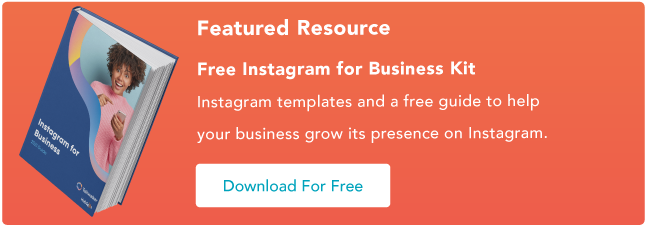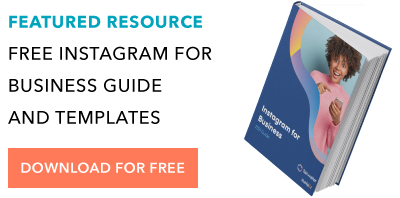More companies are using Instagram in 2018 than ever before -- there are now over 25 million businesses on Instagram, most of which are small businesses.
To capture a new audience and engage with your existing customers, it's critical you consider using Instagram for your business. With over 800 million Instagram users, Instagram is one of the most popular social media tools at your disposal. Instagram has proven a worthwhile investment for marketing purposes. You're able to market your products to a more targeted and engaged audience, and it's cheaper than more traditional forms of paid advertising.
Instagram has proven a worthwhile investment for marketing purposes. You're able to market your products to a more targeted and engaged audience, and it's cheaper than more traditional forms of paid advertising.
Plus, it's an undeniably powerful tool to spread brand awareness -- in fact, 70% of Instagram users have reported looking up a brand on the platform.
But using Instagram for business purposes can seem daunting, particularly if you've only ever used it for personal use. Here, we're going to explore how to leverage the power of Instagram for all your business needs.
How to Use Instagram for Business
Let's delve into the five strategies you'll need to employ to get the most out of Instagram.
1. Add Value With Your Content
First and foremost, Instagram is a visual platform. To attract an audience, it's critical you spend time delivering high-quality, thoughtful content.
Instagram has the highest engagement rate, surpassing Facebook and Twitter. To succeed on Instagram, it's essential you create valuable content that attracts an audience and encourages them to engage with your business. Consider how you can delight your customers while staying true to your brand.
You don't need to just post images of your product to spread brand awareness and increase sales. In fact, in some cases, it's better if you don't. For instance, Hot Pockets sells microwaveable pocket sandwiches. Admittedly, I wasn't much of a fan of Hot Pockets -- until I began following their business's Instagram account.
There are only so many times you can post a picture of a sandwich. Hot Pockets goes in a different direction. Instead, they appeal to their audience through humor, often posting relevant memes or funny quotes.
For instance, in response to @ShallowDivers' claim that Hot Pockets aren't sandwiches, Hot Pockets responded with this:
Ultimately, it might take trial and error to find the content that works best for your business.
While Hot Pockets relies on humor, other brands like The North Face use impressive adventure images to appeal to their demographic.
The point is, brands need to add value to Instagram's community, rather than using the platform for advertisements alone. This is critical for your long-term success.
2. Maintain a Consistent Theme
Imagine each Instagram post as an individual page of your website -- while each post should be good on its own, ideally, you'll need to create a cohesive theme to maintain an audience's loyalty.
It's important to note, I mean "theme" in the broad sense, as it relates to everything from hashtags and captions to Stories and photos. You'll need to create a consistent tone of voice, and unified feed aesthetic. Ultimately, the more specific and consistent you are with your posts, the more likely you are to attract your most authentic audience.
You might think it's better to appeal to more people through various themes, but ultimately, staking your claim in a specific niche will help you create stronger, more genuine connections.
For instance, consider MVMT. Their feed is undoubtedly consistent, with similar filters and color palette, and an emphasis on darker, edgier images:
Their consistency is equally obvious in their captions, with phrases like "Create a life you can't wait to wake up to", and "Unexplored paths lead to undiscovered stories". In every post, you'll see the same hashtag -- "#jointhemvmt".
Undoubtedly, their followers both expect and prefer this type of content, or they wouldn't have followed them in the first place. To continue delighting customers, it's essential MVMT keeps true to their theme.
3. Engage With Your Audience
Engaging with your audience helps your followers feel valued and, as a result, more connected to your business.
There are plenty of ways to engage with your audience. You might reply to comments on your posts, participate in comment threads, run contests or giveaways, use Instagram Stories polls feature, or give shout-outs to followers on your Stories, particularly if they post something relevant to your brand.
Halo Top Creamery does a fantastic job engaging with their audience. They frequently post cute ice cream pictures with the caption "Ice cream is better with friends. Tag a friend you'd like to eat this with." A simple "tag a friend" caption is an effective strategy for growing your audience, since your followers will then tag friends who might not know about you yet.
Additionally, Halo Top often does contests and giveaways, like this one:
By tagging winners in their posts, Halo Top incentivizes other followers to engage with their brand in the future. Additionally, Halo Top's giveaways demonstrate their genuine commitment to connecting with their audience.
4. Consider Influencer Marketing
As a consumer, you've likely seen the recent influx of influencer marketers on Instagram -- and for good reason. By leveraging the power of an influencer, who is already authentically connected with her audience and is seen as a trusted source of information, you're able to spread brand awareness and drive sales.
Micro-influencing in particular is a strong opportunity for brand endorsement. In fact, one survey found 82% of consumers are highly likely to follow a recommendation made by a micro-influencer. That number surpassed the amount of consumers who are willing to follow a recommendation from an average person, like a family member or friend.
You could use your budget and resources to invest in traditional advertising, but it's often easier to create a more targeted, effective marketing campaign through influencer marketing. Ultimately, influencers have already cultivated an engaged, loyal following -- by identifying the right influencers for your niche, you're much more likely to find followers who will truly enjoy and support your products or services.
5. Implement an Instagram Ad Campaign
There are two reasons you might use Instagram ads -- to spread brand awareness, or to increase sales.
It's critical you focus on one goal when creating an effective ad campaign. An Instagram ad aiming to sell a product will look vastly different from one intending to attract followers.
For instance, consider this Greenchef ad that showed up on my Instagram feed today. With various images of delicious food and an enticing "$40 OFF" discount, it's likely a high-converting ad. It's very clear what Greenchef's goal is -- to get people to buy their product.
YouTube, on the other hand, invested in Instagram ads for an entirely different reason. Their advertisements, featuring well-known singers like Camila Cabello, entice followers to simply follow YouTube Music's Instagram channel (and, ideally, YouTube's music channel itself).
To implement an effective campaign, it's essential you decide what you're hoping to achieve before you begin creating it.
Once you've chosen a goal, you'll want to create the ad creative. Similar to what we discussed in strategy one, you'll need to create high-value visual content if you want your ad to be successful. Take a look at other ads on Instagram and consider how you might emulate them.
Additionally, A/B test multiple variations of the same ad (changing the copy, image, or targeted audience for each version), to figure out what works best for your business.
When you're ready to create your ad, you'll need to use Facebook Ads Manager. Among other things, Ads Manager lets you narrow in on your target audience (including location, age, and various interests of your ideal demographic), choose your ad objective, and analyze ad performance.
Instagram Business Profile
A business profile legitimizes your Instagram account, and enables you to add critical information like your company's business hours, location, and phone number.
Additionally, you must have a business profile to get metrics on how your Stories and posts perform throughout the day, and track how your followers engage with your content.
Plus, you'll need to switch to a business profile to create ad campaigns or add links to your Instagram Stories.
When you're ready to switch to a business profile, follow these six easy steps:
1. Click the "Settings" gear on your profile.
2. Scroll down and click "Switch to Business Profile".
3. Here, you'll need to connect to your business's Facebook Page. If you don't have one, here's how to set one up. If you do, select "Choose Page".
4. Ensure your business's Facebook page is selected, then click "Next" in the top right. Alternatively, if you don't already have one, you're given the option to create a page here by clicking "Create a Page".
5. Input your business information, including your business's telephone number, email, and address. Finally, you must un-select "Private Account" to have a business account. When you're ready, press "Done" in the top right.


No comments:
Post a Comment